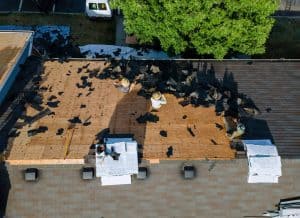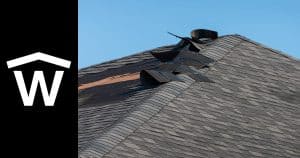Calgary’s climate is a rollercoaster of temperature changes. From the heat of summer to the chill of winter, your roof is put to the test. But it’s not just the extremes of the seasons that you need to worry about. In Calgary, spring and fall can bring major temperature swings, sometimes even within a 24-hour period.

In fact, Alberta holds the national title for recording the most dramatic temperature change in Canada. On January 10, 1962, Pincher Creek experienced a staggering 41°C temperature rise due to Chinook winds, going from -19°C up to 22°C. These Chinooks, which occur on average 30 to 35 times a year in southern and central Alberta, including Calgary, can have a significant impact on your roof’s integrity.
In this comprehensive guide, we’ll delve into the science behind how these temperature changes affect your roof, why investing in quality materials and professional installation is essential, and the common issues that can arise due to Calgary’s unique climate. For more on this fascinating weather phenomenon, refer to this Global News article.
The Science Behind Temperature Changes and Roofing Materials
Understanding the science behind how temperature changes influence different parts of your roof is crucial for effective maintenance and longevity. In this section, we’ll explore the principles of thermal expansion and contraction, the role of water in roof damage, and how various areas of your roof are impacted by Calgary’s unique climate.
Thermal Expansion and Contraction
One of the fundamental principles of physics is that materials expand when heated and contract when cooled. This phenomenon is known as thermal expansion and contraction. In Calgary, where temperatures can swing dramatically, this principle is especially relevant. Roofs are built tough, but even the sturdiest materials can suffer from the effects of constant expansion and contraction.
Water’s Role in Roof Damage
Water can seep into small cracks and gaps in your roof. When the temperature drops, this water freezes and expands, widening the cracks. This is similar to how potholes and cracks form in the road during winter. Regular maintenance is crucial to catch these issues before they escalate.
How Temperature Changes Affect Different Areas of the Roof

- The Attic: Temperature fluctuations can lead to “attic rain,” where condensation forms and drips inside the attic. Proper insulation and ventilation are key to preventing this.
- The Gutter: In colder temperatures, ice can form in the gutters, leading to ice dams that prevent proper drainage.
- Flashing and Shingles: These are often the first to show signs of wear and tear due to temperature changes. For those using asphalt, rubber, or Euroshield shingles, and cedar or wooden materials, it’s essential to understand how these materials react to Calgary’s climate to ensure longevity.
Now that we’ve covered the science behind how temperature changes affect your roof, let’s delve into why investing in quality materials and professional installation is not just an option but a necessity in Calgary’s unique climate.
Common Roofing Issues in Calgary’s Dramatic Climate
Now that we’ve delved into the science behind how temperature changes can affect your roof, let’s look at some of the practical implications. Calgary’s unique weather patterns can lead to a variety of roofing issues that every homeowner should be aware of.
Ice Dams
Ice dams are a frequent issue in Calgary, especially during the winter months. These occur when snow melts on the warmer parts of your roof and refreezes on the colder edges, creating a dam that prevents proper drainage. For more information on how to prevent ice dams, read our comprehensive guide on dealing with and preventing ice dams.

Attic Rain
As we mentioned earlier, temperature fluctuations can lead to “attic rain,” where condensation forms and drips inside the attic. Proper insulation and ventilation are key to preventing this issue. Learn more about attic rain in our guide on attic rain in Calgary.
Flashing and Shingle Damage
Temperature changes can cause the flashing and shingles to expand and contract, leading to potential leaks and water damage. Regular inspections and maintenance are crucial for early detection and repair.
Gutter Issues
In colder temperatures, ice can form in the gutters, leading to ice dams that prevent proper drainage. Keeping your gutters clean and free of debris can help mitigate this issue.
Cracked or Warped Materials
Extreme temperature changes can cause roofing materials to crack or warp over time. This is especially true for less durable materials.
Understanding these common issues is the first step in proactive roof maintenance. Next, we’ll discuss why investing in quality materials and professional installation is not just an option but a necessity in Calgary’s unique climate.
Why Investing in Quality Roofing is Crucial in Calgary
Investing in your roof is not just about picking the right materials; it’s about making a long-term commitment to your home’s safety and durability. In this section, we’ll discuss why quality materials and professional installation are non-negotiable in Calgary’s challenging climate.
The Importance of Material Selection
In Calgary, where we experience everything from Chinooks to dramatic temperature swings, the choice of roofing material is more than just a matter of preference—it’s a critical decision that impacts your roof’s longevity. While options like asphalt, rubber, or Euroshield shingles, as well as cedar or wooden materials, each have their merits, what’s most important is finding the right fit for you, your home, and your budget. We work closely with you to navigate the array of products available, ensuring that you make an informed decision tailored to your specific needs and circumstances.
Professional Installation: A Must in Calgary
A roof is only as good as its installation. Even the best materials can fail if not installed correctly. In Calgary, where the weather can be unforgiving, professional installation is not just recommended—it’s a necessity. Learn more about common installation errors and how to avoid them in our guide on how to spot an improperly installed roof and how to avoid it.
The Cost of Cutting Corners
Skimping on quality can lead to a host of problems down the line, from frequent repairs to potential structural damage. Investing in quality materials and professional installation may cost more upfront, but it pays off eventually through reduced maintenance expenses and a longer lifespan for your roof. It’s worth noting that a poorly executed installation can waste perfectly good materials, sometimes requiring the entire roof to be redone. So, if a friend offers to do the job for half the price, proceed with caution. While they may have good intentions, they likely lack the proper tools and experience to execute a professional-quality installation.
If you’re looking for a roof that can take a beating and help you save money for years to come, then give us a shout.


